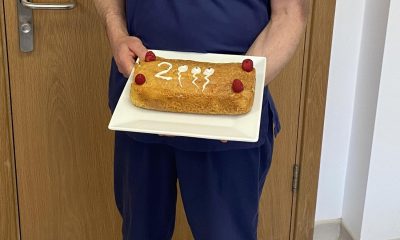Study: Eating only during the day can boost health of people with Type 2 diabetes
Limiting this to a maximum 10-hour window was found to improve metabolism.
Published
2 years ago onBy
Talker News
By Mark Waghorn via SWNS
Eating only during the day boosts the health of people with Type 2 diabetes, according to new research.
Limiting food intake to a maximum 10-hour window was found to improve metabolism, scientists say.
Time-restricted eating (TRE) has been made trendy by stars like Jennifer Aniston and Reece Witherspoon - with some increasing daily fasting periods for up to 16 hours.
Lead author Professor Patrick Schrauwen, of Maastricht University, said: "Our modern 24-hour society is characterized by endless food availability and disrupted day-night rhythm brought on by irregular sleep-activity patterns and frequent exposure to artificial light sources.
"In Western nations, people also tend to spread their daily food intake over a minimum of 14 hours, which is likely to result in the absence of a true, nocturnal fasted state.
"These factors all contribute to the development of ty[e 2 diabetes which has become one of the most common metabolic diseases globally, estimated by the World Health Organisation to cause more than 1.5 million deaths per year."
The form usually develops in middle age - and is linked to unhealthy lifestyles. It affects around 4.5 million Britons - and is caused by too much glucose.
In the study, TRE was found to decrease 24-hour levels - mainly as a result of lower nocturnal blood sugar.
Average time spent with blood glucose in the normal range increased from 12.2 to 15.1 hours.
Morning fasting glucose was consistently lower among the TRE group than those on a control diet.
What is more, it did not increase the risk of low blood sugar or hypoglycemia, and there were no serious adverse effects.
Professor Schrauwen said: "A daytime 10-hour TRE regimen for three weeks decreases glucose levels and prolongs the time spent in the normal blood sugar range in adults with Type 2 diabetes as compared with spreading daily food intake over at least 14 hours. These data highlight the potential benefit of TRE in Type 2 diabetes."
He explained: "An eating window of approximately ten hours is a safe and effective lifestyle intervention for adults with Type 2 diabetes."
The Dutch team described the findings in Diabetologia as "promising". They also add to a growing body of evidence that late-night snacking is bad for health.
Previous studies have shown TRE helps overweight or obese individuals burn more fat, reduce blood sugar and increase sensitivity to the glucose-controlling hormone insulin.

But they had not been analyzed in detail and used extremely short eating windows of six to eight hours in highly managed settings difficult to implement in daily life.
TRE is sometimes accompanied by unintended weight loss which would be expected to increase metabolic health.
But such improvements have also been reported in the absence of weight loss, indicating that additional mechanisms are involved in how restricted eating influences metabolism.
Professor Schrauwen and colleagues recruited 14 patients aged 50 to 75 with a BMI (body mass index) of at least 25. They had all been diagnosed with Type 2 diabetes.
The study consisted of two three-week interventions during which they were assigned to either the TRE or control (CON) group - with a four-week 'wash-out' period.
At the start of each period, participants had their weight measured and were fitted with a continuous glucose monitoring (CGM) device which measured their blood sugar level every 15 minutes.
They were instructed to keep to their normal sleep patterns and physical activity and to maintain a stable weight.
A food and sleep diary completed during the first intervention was used to ensure that diet during the second was similar in both quantity and quality.
During TRE they were instructed to consume their normal diet within a 10-hour window during the daytime and to complete their food intake no later than 6 p.m.
Outside this time window, they were permitted to drink water, plain tea, or black coffee, and zero-calorie soft drinks were also allowed during the evening if consumed in moderation.
During CON volunteers were only required to spread their normal food intake over at least 14 hours, with no other restrictions.
The eating window for TRE averaged 9.1 h compared to 13.4 h in CON, while sleep-wake patterns were similar in each case with mean sleep duration of 8.1 h and 8.0 h, respectively.
Mean body mass was comparable at the start of both TRE and CON and although volunteers were instructed to remain weight stable, a small but statistically significant weight loss occurred in response to TRE but not CON.
Halfway through each intervention, liver glycogen levels were assessed in the morning following the 10 or 14-hour night-time fast period and were measured again at the end of each study period after an 11-hour fast for both TRE and CON.
In both cases, liver glycogen did not differ significantly between TRE and CON and analysis of liver fats showed no difference in their quantity or composition between interventions.

Professor Schrauwen said: "Mechanisms underlying the improvement in glucose regulation upon TRE remain unclear.
"Our results show that TRE did not improve peripheral and liver insulin sensitivity, skeletal muscle mitochondrial function, energy metabolism or liver fat content, all of which are known to be affected in Type 2 diabetes."
The researchers say the mechanisms involved in the effects and their implications should be investigated further, with a particular focus on studying nocturnal glucose metabolism in more detail.
Unlike a previous study into TRE, this one did not show that the protocol had any effect on insulin sensitivity.
But the earlier research had used a much shorter six-hour food intake window with the last meal being consumed at 3 p.m.
This resulted in a longer fasting period which may have been more effective but was felt to be unrealistic to incorporate into the lifestyle of most adults with type 2 diabetes.
Professor Schrauwen said: “Future studies will be needed to reveal whether the duration of the fasting period is indeed crucial in determining positive effects on insulin sensitivity.
"Since our TRE protocol was feasible and safe, and resulted in improved 24-hour glucose levels, it would be interesting to examine the impact of 10 h TRE on glucose regulation and insulin sensitivity in Type 2 diabetes in the long term to address the clinical relevance of TRE."
Previous research in mice has indicated people should stick to eating during the daytime.
Lab rodents are nocturnal animals. When they were given meals just at night, longevity increased by a third.
Cutting down on fatty and sugary foods and having meals at the right time could add years to the human lifespan, said the University of Texas team.
Scientists are just beginning to understand how calorie restriction slows aging at the cellular and genetic levels.
As an animal age, genes linked to inflammation tend to become more active while those that regulate metabolism slow up.
Calorie restriction, especially when timed to the mice's active period at night, helped offset these genetic changes as they got older.
Stories and infographics by ‘Talker Research’ are available to download & ready to use. Stories and videos by ‘Talker News’ are managed by SWNS. To license content for editorial or commercial use and to see the full scope of SWNS content, please email [email protected] or submit an inquiry via our contact form.
You may like


Metals can heal themselves just like ‘The Terminator’


Two-faced star has hydrogen on one side and helium on other


World’s oldest big game hunting weapon found


An espresso a day could keep Alzheimer’s at bay


Being bipolar significantly raises risk of premature death: study


Soccer players who regularly use head more likely to develop Alzheimer’s
Other Stories


Shop owner discovers Victorian jail cells hidden in her basement
She purchased the store having no idea about it history.


Scientists explain why there are ‘spiders’ on Mars
The creepy crawlies are actually small, dark features that form when this happens.


Doctor celebrates 2000th vasectomy with a sperm-themed cake
He says he hopes to raise awareness about the procedure.


Dog theft causes same emotional turmoil as losing a child: study
Some felt the loss was even more intense than the death of a friend or relative.


New innovative submarine looks just like a UFO
It has been specifically designed for the cruise and hospitality sectors.
Top Talkers

 Parenting1 week ago
Parenting1 week agoSingle mom details struggles of feeding her 12 kids

 Lifestyle6 days ago
Lifestyle6 days agoWoman regrets her tattoo nightmare: ‘It’s horrendous’

 Good News3 days ago
Good News3 days agoDisabled student takes first steps in 10 years on graduation stage

 Health3 days ago
Health3 days agoNew study reveals ‘old age’ begins later than it used to

 Wildlife2 days ago
Wildlife2 days agoClever elephant returns visitor’s shoe that fell into enclosure

 Broadcast1 week ago
Broadcast1 week agoHow hard is it for Americans to live sustainably?

 Environment1 week ago
Environment1 week agoHow hard is it for Americans to live sustainably?

 Work1 day ago
Work1 day agoHow much does your workspace affect productivity?
